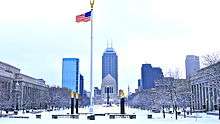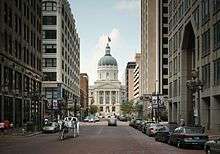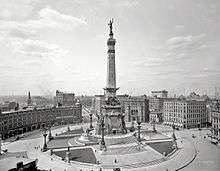Downtown Indianapolis
The term Downtown Indianapolis refers to the central business district of Indianapolis, Indiana, United States. The boundaries of downtown Indianapolis have varied over time as the city has grown. The city's original platted area, the Mile Square, (bounded by North, South, East, and West streets) is sometimes used to denote the downtown area. However, the Indianapolis Regional Center Plan, which is the official plan for Downtown Indianapolis,[1] defines the boundaries to be 16th Street on the north, Interstate 65/70 on the east, Interstate 70 on the south and the Belt Railroad on the west.[2] The Regional Center therefore encompasses not only the Mile Square, but also the Indiana University – Purdue University Indianapolis campus, White River State Park, and the Eli Lilly and Company corporate headquarters.

History

Indianapolis's downtown has undergone a transformation from a place of vacant storefronts and little activity to that of a dynamic urban district. In the 1970s, the city suffered from the problems that affected other Rust Belt cities, such as decreased economic activity, white flight, and racial tension. The City of Indianapolis dealt with these issues and came up with solutions to revitalize the city's downtown.
Modern skyscrapers were constructed in the area during the 1980s, including the Chase Tower (built 1990). Revitalization of the Central Canal followed. This, along with plans for a new downtown mall, basketball arena, and new attractions such as museums, helped to revitalize Downtown Indianapolis.
Thirty-six apartment buildings in downtown Indianapolis are listed on the National Register of Historic Places in the Apartments and Flats of Downtown Indianapolis Thematic Resources.[3]
Tourism
Tourism is a large part of the economy of Downtown Indianapolis, due in large part to the presence of the Indiana Convention Center. White River State Park attracts tourists with its many offerings: the Eiteljorg Museum of American Indians and Western Art, the Indiana State Museum, the NCAA Hall of Champions, the Indianapolis Zoo, the White River Gardens and the Central Canal, which connects the park to other parts of downtown. Lucas Oil Stadium and Bankers Life Fieldhouse host professional sports as well as music concerts and other events. The Soldiers' and Sailors' Monument and the Indiana World War Memorial Plaza are two historical landmarks in Downtown Indianapolis.
Shopping and cinemas
Downtown Indianapolis attractions include the Circle Centre Mall, which is considered to be one of the most successful downtown malls in the country. Circle Centre Mall also has GameWorks Studios arcade (now known as Tilt) and a nine-screen United Artists movie theater. The Indiana State Museum has an IMAX theater that shows documentaries and delayed releases of commercial IMAX movies. The Massachusetts Avenue Cultural District is home to a number of independent shops and boutiques.
Transportation

Although Downtown Indianapolis is home to the first Union Station in the world, demonstrating the city's late nineteenth-century heritage as a rail hub, only two trains currently stop in Indianapolis, Amtrak's Hoosier State and Cardinal. The waiting area and Greyhound bus station are located underneath Union Station's trainshed. Megabus is another bus service that connects downtown Indianapolis to Chicago, Cincinnati, and Columbus, Ohio
IndyGo is the city bus service that connects downtown to other parts of the city.
Attractions

Developments in Downtown Indianapolis include the creation of the Cultural Trail throughout downtown,[4] construction of new mid to high rise buildings,[5] and the enlargement of the convention center.[6]
Cultural districts
Five of the six designated Cultural Districts of Indianapolis are in or adjoining downtown. They are Massachusetts Avenue, Fountain Square, the Wholesale District, the Canal and White River State Park, and Indiana Avenue. These areas have held historic and cultural importance to the city. In recent years they have been revitalized and are becoming major centers for tourism, commerce and residential living.

Georgia Street in downtown was renovated to serve as Super Bowl Village during Super Bowl XLVI, and as an outdoor event space after the Super Bowl.
White River State Park is considered America’s only urban cultural state park with attractions like Indiana State Museum and IMAX Theater, Indianapolis Zoo and White River Gardens, the Eiteljorg Museum of American Indian and Western Art, NCAA Headquarters and NCAA Hall of Champions, the Congressional Medal of Honor Memorial, Victory Field as home of the Indianapolis Indians Baseball, Military Park and an outdoor concert area called Lawn.
Night life
The downtown's main nightlife is located on Meridian Street and Massachusetts Avenue. The night clubs and bars are located on Meridian Street between the Monument Circle and Lucas Oil Stadium. Massachusetts Avenue is a diverse location with multiple European bars and restaurants and is often considered as a hip and cosmopolitan neighborhood of the downtown. Some of the night clubs and bars near Meridian Street include Bartinis, Cadillac Ranch, Sensu, Ice Ultra Lounge, 6 Lounge, Blu, Subterra Lounge, Ugly Monkey, Slippery Noodle Inn, Howl at the Moon, Tiki Bob's, Claddagh Irish Pub, Kilroy's Bar and Grill, Hard Rock Cafe, Jillian's, Scotty's Brewhouse and a cigar lounge called Nicky Blaines.[7] Mass Ave bars include Front Page Grill, Bazbeaux Pizza, Old Point Tavern, Bu Da Lounge, Chatterbox, Mesh on Mass, FortyFive Degrees, and Metro. Mass Ave also has various European bars that include MacNiven's (Scottish), Chatham Tap (English), and The Rathskeller (German).[8] There are many other bars located around the Downtown area.
Cultural Trail
Complete in 2013, the Indianapolis Cultural Trail is an urban bike and pedestrian path that connects the city's five downtown Cultural Districts, neighborhoods, and entertainment amenities, and serves as the downtown hub for the entire central Indiana greenway system. The trail includes benches, bike racks, lighting, signage and bike rentals/drop-offs along the way and features local art work.
Venues
Downtown Indianapolis has three venues. Lucas Oil Stadium is the home of the NFL Indianapolis Colts and also hosts concerts and other sporting events including college basketball and it hosted Super Bowl XLVI. Bankers Life Fieldhouse is the home of NBA's Indiana Pacers and WNBA's Indiana Fever and it hosts concerts and other sporting events. Victory Field is the home of Indianapolis Indians.
NCAA Hall of Champions
The NCAA Hall of Champions is a museum, exhibition center, and conference center located adjacent to the national office of the National Collegiate Athletic Association (NCAA) in White River State Park. The building was designed by architect Michael Graves.
Monument Circle
At the center of Indianapolis is Monument Circle, a traffic circle at the intersection of Meridian and Market Streets, featuring the Soldiers' and Sailors' Monument. Monument Circle is depicted on the city’s flag. It is in the shadow of Indiana's tallest skyscraper, the Chase Tower. Until the early 1960s, Indianapolis zoning laws stated that no building could be taller than the Soldiers and Sailors Monument. Each Christmas season, lights are strung onto the monument and lit in a ceremony known as the Circle of Lights, which attracts tens of thousands of Hoosiers to downtown Indianapolis on the day after Thanksgiving.
War Memorial Plaza

A five-block plaza at the intersection of Meridian and Vermont surrounds a large memorial dedicated to Hoosiers who have fought in American wars. It was originally constructed to honor the Indiana soldiers who died in World War I, but construction was halted due to lack of funding during the Great Depression, and it was not completed until 1951. The purpose of the memorial was later altered to encompass all American wars in which Hoosiers fought.
The monument is modeled after the Mausoleum of Maussollos. At 210 feet (64 m) tall it is approximately seventy-five feet taller than the original Mausoleum. On the north end of the War Memorial Plaza is the national headquarters of the American Legion and the Indianapolis Public Library's Central Library.
Monuments

The city is second only to Washington, D.C., for number of war monuments inside city limits.[9]
- The Soldiers' and Sailors' Monument, located at Monument Circle in the geographic center of the city.
- Indiana World War Memorial Plaza
- Medal of Honor Memorial
- USS Indianapolis Memorial
- Landmark for Peace Memorial
- Project 9/11 Indianapolis
Murat Centre
The Murat Shrine, now officially known as Old National Centre and originally known as the Murat Temple and Murat Centre, is an entertainment venue in Indianapolis, Indiana, owned by the Murat Shriners of the Ancient Arabic Order of the Nobles of the Mystic Shrine. It is the oldest stage house in downtown Indianapolis that is still standing, the only Shrine temple in the world with a French-originating name, and the largest Shrine temple in North America.[10][11]
Other attractions

Other attractions in Downtown Indianapolis include:
Public art
The first instances of permanently installed public art begin in the early 1970s and include the following artworks:
- Obos by George Tsutakawa (1971)
- Untitled by Peter Mayer (1972)
- Untitled by Roland Hobart (1973)
- Color Fuses by Milton Glaser (1974)
- Quaestio Librae by Jerry Sanders (1975)
- The Runners by James McQuiston (1975)
- Snowplow by Mark Di Suvero (1968) first installed in 1977
Today there are many more public artworks in downtown and all around the city.
Hotels
Downtown Indianapolis has a variety of hotels ranging from skyscrapers to small motels. Downtown has over 7,100 rooms, with over 4,000 of those rooms in hotels that are connected via a system of skywalks.[12] Some of the notable hotels in the skyline include JW Marriott Indianapolis, Hilton Indianapolis, Le Méridien Indianapolis Hotel, Conrad Indianapolis, Hyatt Regency Indianapolis, Hilton Garden Inn, Sheraton Indianapolis City Centre, Marriott Indianapolis, Omni Severin Hotel and the historic Columbia Club.
Hospitals
Several major hospitals are located in downtown Indianapolis, namely the Eskenazi Hospital; the Richard L. Roudebush VA Medical Center; and the Academic Health Center of Indiana University Health, which includes University Hospital, the Simon Cancer Center, Riley Hospital for Children, and Methodist Hospital. IU Health operates its facilities as a single hospital and has constructed a people mover to connect them.
References
- ↑ Archived August 7, 2011, at the Wayback Machine.
- ↑ Archived July 5, 2007, at the Wayback Machine.
- ↑ National Park Service (2009-03-13). "National Register Information System". National Register of Historic Places. National Park Service.
- ↑ "Home - Indianapolis Cultural Trail : Indianapolis Cultural Trail". Indianapolis Cultural Trail. Retrieved 20 December 2014.
- ↑ "Downtown Indy". DowntownIndy. Retrieved 20 December 2014.
- ↑ Archived October 17, 2006, at the Wayback Machine.
- ↑ "Indianapolis - DOWNTOWN Night Club List". Indymotorspeedway.com. Retrieved 20 December 2014.
- ↑ https://web.archive.org/web/20110822000243/http://indianapolis.metromix.com/facets/bars-and-clubs/loc.indianapolis_market.indianapolis.marion.downtown. Archived from the original on August 22, 2011. Retrieved August 24, 2011. Missing or empty
|title=(help) - ↑ "Marine training in Indy stirs concerns". Indianapolis Star. 2008-06-03. Archived from the original on July 13, 2014. Retrieved 2008-06-05.
- ↑ Bodenhamer, David. The Encyclopedia of Indianapolis (Indiana University Press, 1994) pg.1026, 1027
- ↑ "Downtown Indy". DowntownIndy. Retrieved 20 December 2014.
- ↑ https://blogs.butler.edu/multimedia-journalism/2012/12/04/indianapolis-hotels/
External links
- Panorama of Downtown Indianapolis on Windows Local Live
- Indianapolis Downtown, Inc. website
- Indianapolis Visitors and Convention Bureau official website
- Official City of Indianapolis website
- Things to do in Indianapolis website
Coordinates: 39°46′07″N 86°09′32″W / 39.7685°N 86.159°W